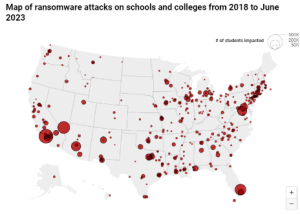 In a time where technology encompasses our personal and professional lives, the threat of cyber-attacks looms large over various industries. Cybercriminals are constantly seeking new ways to exploit vulnerabilities, and certain sectors are particularly susceptible due to the sensitive nature of the data they handle and the critical services they provide. In this article, we will delve into five industries most vulnerable to cyber-attacks: Public administration, Healthcare & Pharmaceuticals, Finance & Insurance, Education & Research, and Retail.
In a time where technology encompasses our personal and professional lives, the threat of cyber-attacks looms large over various industries. Cybercriminals are constantly seeking new ways to exploit vulnerabilities, and certain sectors are particularly susceptible due to the sensitive nature of the data they handle and the critical services they provide. In this article, we will delve into five industries most vulnerable to cyber-attacks: Public administration, Healthcare & Pharmaceuticals, Finance & Insurance, Education & Research, and Retail.
Public Administration
The public administration sector, covering government bodies and agencies, is a prime target for cyber-attacks due to the massive amount of sensitive information it holds. Breaches in this sector can compromise national security, and citizen data, and even disrupt essential public services. Cyber-attacks on public administration can result in data theft, espionage, and manipulation of critical infrastructure, highlighting the need for robust cybersecurity measures and constant vigilance. According to Reuters, as recently as June 15, the US Energy Department and other agencies were targets of a global hacking spree.
Healthcare & Pharmaceuticals
The healthcare and pharmaceutical industries are entrusted with vast amounts of personal and medical data. This sensitive information is not only valuable to cyber criminals for financial gain but also for blackmail or identity theft. Recent years have seen a surge in attacks on healthcare institutions, such as ransomware attacks that can cripple hospitals’ operations, potentially putting patient lives at risk. The nature of medical devices and electronic health records amplifies the vulnerability of this sector. According to HealthITSecurity.com, the healthcare industry has suffered close to 300 breaches in the first half of 2023. Included in that count is Managed Care of North America who suffered a major data breach earlier this year impacting over 8.8 million individuals.
Finance & Insurance
The finance and insurance sectors are the lifeblood of our economy, making them appealing targets for cyber criminals. Financial institutions store troves of financial data, including credit card information, bank account details, and personal identification. A breach in this sector can lead to catastrophic financial losses. Phishing attacks, ransomware, and insider threats are just a few of the tactics that attackers employ to exploit weaknesses in financial systems. According to Insurance Business Mag, the attacks on this sector are growing. Prudential had a breach just a couple of months ago that affected over 320,000 customers. New York Life (NYLIC), Genworth Financial, Progressive Insurance, MCNA were also compromised in May.
Education & Research
 The education and research sector are progressively more dependent on technology for teaching, learning, and data management. As a result, educational institutions hold a wealth of sensitive information, including student records, research data, and intellectual property. Cyber-attacks targeting these institutions can disrupt academic activities, compromise research findings, and expose student and staff data. The decentralized nature of academia can make it challenging to enforce consistent cybersecurity protocols across institutions. The cost of Ransomware attacks on US schools and colleges, in 2022 the cost was more than $9.45 billion dollars in downtime, affecting more than a million students. You can read Paul Bischoff’s July 4th article.
The education and research sector are progressively more dependent on technology for teaching, learning, and data management. As a result, educational institutions hold a wealth of sensitive information, including student records, research data, and intellectual property. Cyber-attacks targeting these institutions can disrupt academic activities, compromise research findings, and expose student and staff data. The decentralized nature of academia can make it challenging to enforce consistent cybersecurity protocols across institutions. The cost of Ransomware attacks on US schools and colleges, in 2022 the cost was more than $9.45 billion dollars in downtime, affecting more than a million students. You can read Paul Bischoff’s July 4th article.
Retail
The retail industry’s vulnerability to cyber-attacks stems from its dependence on online transactions and the storage of customer payment information. E-commerce platforms, point-of-sale systems, and customer databases are all potential entry points for cybercriminals. Large-scale data breaches in the retail sector can lead to financial fraud, identity theft, and reputational damage. The increasing integration of Internet of Things (IoT) devices in retail operations further widens the attack surface. A few examples of high-profile retail data breaches so far this year are MOVEit, T-Mobile, Yum! Brands (KFC, Taco Bell, Pizza Hut), Chick-fil-A, Norton Life Lock, and Mailchimp.
NOTE
The breaches that I mention in this post, are only the ones that have been reported. More than 85% of cyberattacks go unreported. They are still happening every day in all types of businesses just like yours.
In an increasingly interconnected world, cyber-attacks have become an ever-present threat across various industries. Public administration, healthcare & pharmaceuticals, finance & insurance, education & research, and retail are among the sectors most vulnerable to these attacks due to the nature of the data they handle and the services they provide. As cyber criminals advance their strategies, these industries must prioritize cybersecurity measures, invest in training, adopt robust encryption practices, and establish incident response plans to mitigate the risks posed by these relentless adversaries. Only through proactive efforts can industries safeguard their critical assets and maintain public trust in an age of escalating cyber threats.